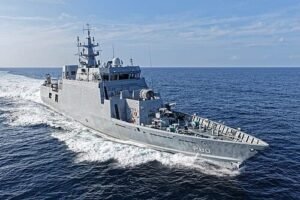Indian Navy Set to Induct Indigenous ASW Ship Mahe
|
General Studies Paper III: Indigenization of Technology, Defence |
Why in News?
The Indian Navy is set to commission ‘Mahe’ as the first indigenous Anti-Submarine Warfare Shallow Water Craft (ASW-SWC) at the Naval Dockyard in Mumbai on 24 November 2205. This reflects the broader push for self-reliance under the Aatmanirbhar Bharat vision.

What is the Anti-Submarine Warfare Shallow Water Craft (ASW-SWC)?
- About: The Anti-Submarine Warfare Shallow Water Craft (ASW-SWC) is a specialised class of naval vessels in the Indian Navy to induct to track, deter, and neutralise hostile submarines operating close to the coastline. The craft offers an integrated structure that supports both defensive patrols and offensive ASW missions.
-
- Developed By: A total of 16 Anti-Submarine Warfare Shallow Water Craft (ASW-SWC) vessels are being built for the Indian Navy by two shipyards: Cochin Shipyard Limited (CSL) and Garden Reach Shipbuilders & Engineers (GRSE).
- Aims: The aim is to conduct mine-laying, subsurface surveillance, search and rescue (SAR), and low-intensity maritime operations (LIMO).
- History: The ASW-SWC programme emerged as a major requirement during the early 2010s, when the Navy reviewed gaps in coastal defence after repeated submarine intrusions in regional waters. The government approved a large project to replace the older Abhay-class corvettes that had served since the late 1980s. The Ministry of Defence signed contracts in April 2019 with two frontline Indian shipyards to build 16 ASW-SWC vessels.
- Design: The craft usually has a displacement of around 900–1000 tonnes, which allows easy navigation in shallow regions. The ship integrates a hull-mounted sonar, underwater communication systems, and radar sensors that track movement above and below the surface. The vessel carries lightweight torpedoes, ASW rockets, and decoy launchers that support quick response to underwater contacts.
About Indigenous ASW Ship ‘Mahe’
- The Indigenous ASW Ship ‘Mahe’ is a new Anti-Submarine Warfare Shallow Water Craft that the Indian Navy is set to induct as part of a major force-modernisation programme on 24 November 2025 at the Naval Dockyard in Mumbai.
- The ship’s development passed through stages of design, fabrication, outfitting, basin trials, and sea trials between 2021 and 2024. The Navy supervised each stage.
- The Navy named the ship after Mahe, a small coastal town on the Malabar Coast that has a distinct cultural and maritime identity. The ship’s crest shows an Urumi, a flexible sword traditionally used in Kalaripayattu, which is one of India’s oldest martial arts.
- Features:
- INS Mahe is the first of eight Anti-Submarine Warfare Shallow Water Craft (ASW-SWC) being inducted by the Indian Navy.
- The ship has a displacement ranging from 896 to 1,100 tons, making it one of the larger shallow water combat vessels in the Indian Navy.
- The vessel is powered by a water-jet propulsion system that provides high manoeuvrability and a top speed of 25 knots, essential for rapid response in anti-submarine operations.
- It is armed with one RBU-6000 anti-submarine rocket launcher and two light-weight torpedo tube launchers.
- It has an operational range of 1,800 nautical miles at 14 knots, enabling extended patrols along India’s littoral and coastal regions.
- The ship carries two rigid-hulled inflatable boats (RHIBs) to support boarding, search and rescue, and small-scale amphibious operations.
- The Mahe-class uses more than 80 percent indigenous content. This level of local production supports national goals under Aatmanirbhar Bharat.
- The vessel operates with a complement of 57 personnel, including 7 officers and 50 sailors, trained for anti-submarine and coastal defence missions.
- The ship is equipped with a DRDO-developed ASW combat suite, Abhay hull-mounted sonar, Low Frequency Variable Depth Sonar (LFVDS), and integrated management systems including FCS, IPMS, APMS, and BDCS for operational efficiency.
Note: INS Malvan and INS Mangrol are part of the same Mahe‑class ASW‑SWC series.
Strategic Significance of Indigenous ASW Ship
- Strengths Coastal Defence: These shallow‑water ASW vessels significantly bolster India’s coastal defence. They are designed to operate where larger warships cannot manoeuvre effectively — in littoral zones and near strategic chokepoints. Their agility and sonar systems help detect and deter enemy submarines close to the shore. This expands India’s layered coastal security network.
- Enhances Anti-Submarine Warfare: The ASW‑SWCs add vital anti-submarine warfare capability to the Indian Navy. They come equipped with sonar, light-weight torpedoes, and ASW rockets. Their induction helps India respond to growing sub-surface threats from regional navies. By doing so, the Navy improves its deterrence and protection of maritime approaches.
- Future Deployment Flexibility: These ships offer high operational flexibility for future deployments. Their shallow draught allows them to navigate tight coastal waters and archipelagic regions. They support both peacetime missions (like maritime domain awareness) and wartime operations (such as ASW combat). This makes them versatile tools in India’s evolving maritime strategy.
- Blue‑Water Ambitions: They also indirectly support India’s blue-water ambitions. A strong coastal zone defence frees up larger surface ships (destroyers, frigates) and submarines to operate in the open ocean. By securing its shores, India can better project power into the Indian Ocean Region (IOR).
|
Also Read: India commissions INS Udaygiri & INS Himgiri |








